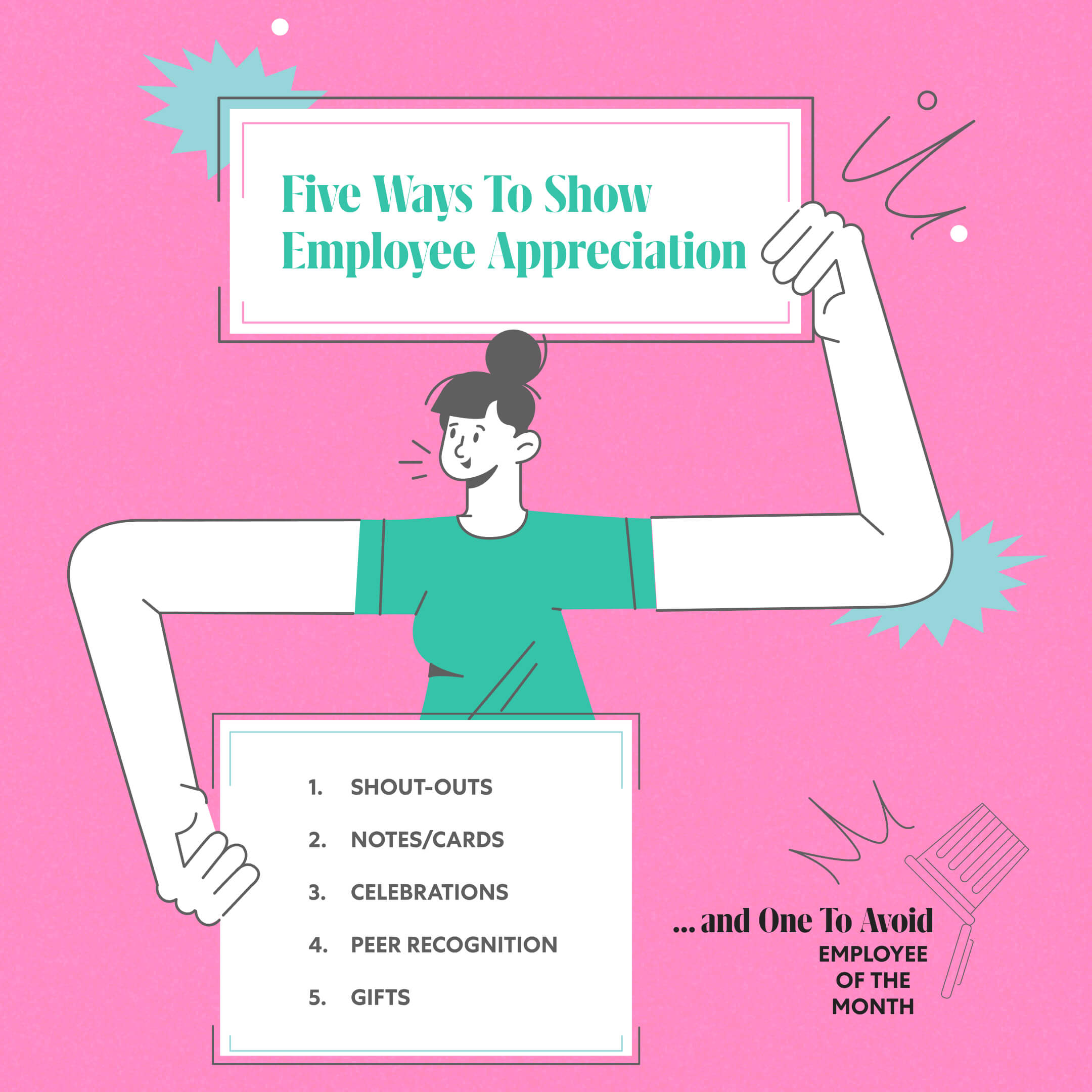5 Ways To Show Employee Appreciation – and One To Avoid

By Fast Company Executive Board
Do you appreciate your employees?
Let’s assume, because you’ve built a successful business, that you have a team of employees. And no matter what the role, from project manager to building maintenance to C-suite, you wouldn’t have hired someone if you didn’t need a job done.
So, you need your people. But do you appreciate them? And just as crucially, do they *know* that you appreciate them?
If not, you’re in trouble. When employees feel under-appreciated, morale drops, productivity tanks, and business outcomes suffer. Plus, you’re likely to lose some of your best people. On the other hand, showing appreciation and gratitude can go a long way toward creating a human-centric workplace that nurtures employee satisfaction.
“We’ve found that gratitude is the foundation for long-lasting loyalty,” says FCEB member Chris Schembra. When managers are effective at recognizing employees, they see lower turnover.”1
Likewise, FCEB member Ivonne Kinser says, “Every person across our organization needs to recognize that their problem-solving talents are extremely valued, not only to drive award-winning innovations but also to solve day-to-day problems that get in the way of our company’s and industry’s progress and evolution.”2
So it’s time to take stock. If you don’t have processes in place to convey gratitude and appreciation for work well done, it’s likely that you’re inadvertently sending the opposite message — that you don’t notice or appreciate your team’s work.
Below, find five great ways to recognize your employees and thank them for a job well done — and one popular old chestnut to avoid.
5 Ways To Show Appreciation for Employees

Shout-Outs
Shout-outs are a common, quick, and effective form of recognition. Notice and comment when someone on your team does something praiseworthy. Be specific. “You did a great job,” is nice, but “You did a great job creating clear, eye-catching graphics for the presentation,” is better. This lets the recipient know you are really paying attention.
Shout-outs offer a quick boost to morale. Here are some ways to deliver them:
- Verbally one-on-one
- Verbally in team meetings or “town hall” gatherings
- Written on a company bulletin board or whiteboard
- Posted on an internal website, wiki, or newsletter
- Posted on social media (Bonus: this gives your employee a burst of public recognition and lets your audience see a little bit of the “real” company behind-the-scenes, building trust and connection)
- Written as a LinkedIn recommendation
Shoutouts are quick, easy, and appreciated. Start today.
Notes/Cards
For a more formal and personal acknowledgement, try a note or card. As the whole world goes digital, a physical note is more noticeable and meaningful than ever.
Former CEO of Campbell’s Soup, Douglas R. Conant, said he penned 30,000 handwritten thank-you notes to his employees over the years. He says, “It’s the least you can do for people who do things to help your company and industry. On the face of it, writing handwritten notes may seem like a waste of time. But in my experience, they build goodwill and lead to higher productivity.”
Don’t let the 30,000 number scare you. Just write one note at a time. Maybe one per day or week. A quick 5-minute note is a strong indication that you value someone’s work.
Celebrations
If your team has accomplished something big, a party may be in order. Pizza parties, ice cream buffets, and happy hours are standbys, but you can be as creative as you like. An afternoon of lawn games or a movie “night” during work hours could be fun. Choose something that your team will enjoy — and celebrate with them. Maybe kick things off with a short sweet speech of thanks.
“Prioritize celebration,” says FCEB member Shannon Lucas. “Many remote leaders fall into the trap of only communicating when there’s a problem or they need something. That can be demotivating for the team. Acknowledge the successes.”3
Peer Recognition
Make appreciation a solid part of your human-centric company culture by empowering any person to thank or compliment a fellow team member. Make it clear that your shout-out system is for everyone. Or, if you’re the CEO doing verbal shout-outs in town halls, for instance, set up another system, like a bulletin board or Slack channel, for the team’s use in acknowledging one another.
FCEB member Krishna Kutty says, “Having a formal recognition program where employees can reward each other for a job well done, based on specific behavior or achievements, is worth implementing to sustain momentum and to align employees to your company values.”4
Gifts
Many companies get annual gifts for their employees, which can be fun, if the gifts are useful and thoughtful. Beware of these terrible office gifts, including books on how to do better at work, stale or melted perishables, and the spoils of a hunting trip (!). Instead, offer your team something you would want to receive. Cash and gift certificates are always safe bets. Company swag (especially clothing like hats and shirts) is also fun, as it creates an “insider” vibe — and who can’t use a free t-shirt?
One Recognition Strategy To Avoid
Employee of the Month
Employee of the month programs, which once seemed like a clever way to motivate people, have fallen into disrepute. This popular strategy backfires easily for several reasons. If your company has more than 12 employees, you can’t even recognize each person once per year. With a monthly program, you “have” to choose someone each month, so even those chosen might feel less valued. Those who aren’t chosen may feel resentment or just disconnect. Finally, and most crucially, a program like this causes competition amongst employees instead of cooperation.
Takeaway
So skip the employee of the month and focus on other ways to express appreciation organically, specifically, and authentically. As Krishna Kutty says, “Actively advocating for your team where possible and ensuring that you recognize their value and contributions is still critical and undervalued.” Shout-outs, notes/cards, celebrations, peer-to-peer recognition programs, and useful gifts are great ways to build a culture of gratitude and ensure that your employees feel appreciated.
Share your ideas about how to show gratitude in the workplace and learn from others about this and other topics like innovation in business by becoming a Fast Company Executive Board Member.
The Fast Company Executive Board is an invitation-only, professional network of company founders, executives, and leaders who are defining the future of business. Visit the Fast Company Executive Board membership page or contact us directly to learn more about becoming a member.
RESOURCES
Fast Company Executive board members offer great advice in the articles quoted above. Links to the full articles can be found in each member’s profile:
- 1 “Gratitude May Be the Secret To Overcoming the Talent Crisis” by Chris Schembra
- 2 “3 Ways To Drive Fearless Innovation and Greater Performance” by Ivonne Kinser
- 3 “The New Normal: How To Drive Innovation While Working Remotely” by Shannon Lucas
- 4 “Retaining Talent During the Great Resignation” by Krishna Kutty




